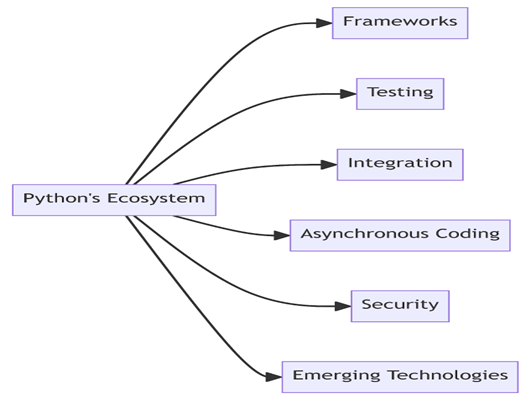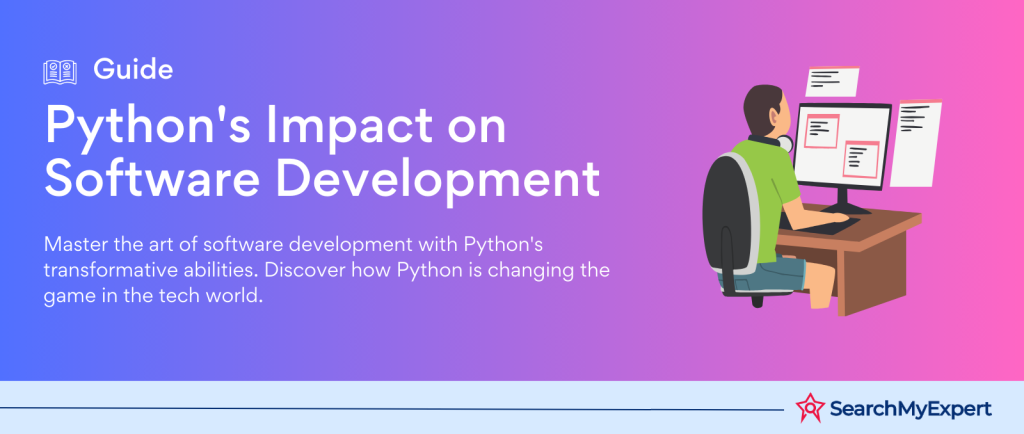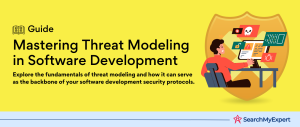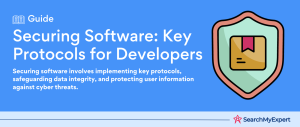Python, a versatile and powerful programming language, has become a leading choice for
software development. Its simplicity, flexibility, and extensive libraries make it an ideal choice for both beginners and seasoned developers. In this comprehensive guide, we’ll delve into the key reasons behind Python’s growing popularity and how it is revolutionizing the software development industry.
Python: A Brief Overview
Python was created by Guido van Rossum and first released in 1991. With its clear syntax and emphasis on code readability, Python promotes a collaborative coding environment. Its open-source nature means that it is constantly evolving, with a dedicated community of developers contributing to its growth.
Key Advantages of Python in Software Development
1. Readability and Maintainability
Python’s syntax is designed to be intuitive and human-readable. This ensures that software developers can easily understand and modify code, reducing the overall maintenance cost.
2. Extensive Libraries
Python boasts a rich standard library, covering areas from web frameworks to scientific computing. This reduces the need to write code from scratch and accelerates the development process.
3. Scalability and Flexibility
Python is known for its scalability, making it suitable for both small-scale applications and large enterprise systems. Its flexibility also allows integration with other languages, ensuring seamless operation.
4. Community Support
With a vast community of developers, Python offers unparalleled support. This means that solutions to potential challenges are readily available, and there’s a wealth of resources for learning and improvement.
5. Cost-Effective
Being an open-source language, Python cuts down on software development costs. Combined with its efficiency and speed, it provides a cost-effective solution for businesses.
Python in Action: Real-World Applications
Python’s capabilities extend across various industries and applications. Some notable examples include:
- Web Development: Frameworks like Django and Flask enable the creation of robust web applications.
- Data Analysis: Libraries such as Pandas and NumPy facilitate data manipulation and analysis.
- Artificial Intelligence: TensorFlow and PyTorch are leading tools in AI development.
- Automation: Python scripts can automate a wide range of tasks, enhancing productivity.
Embracing the Future with Python
The future of software development is inextricably linked with Python. Its adaptability means that it is poised to meet the demands of emerging technologies, ensuring its continued relevance in the years to come.

Python’s Ecosystem: A Deep Dive
- Versatile Frameworks
Python’s expansive range of frameworks caters to a variety of development needs:
- Web Frameworks: Beyond Django and Flask, Python offers Pyramid, CherryPy, and more, each with unique features tailored to different web development requirements.
- GUI Frameworks: Tools like PyQt, Tkinter, and Kivy enable developers to create user-friendly desktop applications.
- Game Development: Pygame is a popular choice for budding game developers, offering a range of functionalities for game creation.
2. Robust Testing Environment
Python’s testing framework empowers developers to validate their applications efficiently:
- Unit Testing: Python’s unittest provides a testing framework that ensures individual units of source code function as intended.
- Integration Testing: Tools like pytest facilitate the testing of integrated software components, ensuring seamless interoperability.
3. Integration Capabilities
Python’s ability to integrate with other programming languages and platforms is unmatched:
- Database Integration: Python seamlessly integrates with databases like PostgreSQL, MySQL, and SQLite, ensuring data-driven applications run efficiently.
- Language Integration: Through tools like Cython, Python can be integrated with languages like C, allowing developers to leverage the strengths of both.
4. Asynchronous Coding
With the introduction of the asyncio library, Python supports asynchronous coding, enhancing the efficiency of I/O-bound operations. This is crucial for applications that require real-time processing, like chat applications or live data feeds.
5. Security and Reliability
Python’s focus on security is evident in its range of security-focused libraries and tools:
- Cryptography: The cryptography library offers cryptographic recipes for developers.
- Authentication: Frameworks like Django come with built-in user authentication systems, ensuring secure user management.
Python in Emerging Technologies
Python’s adaptability is evident in its prominence in emerging tech sectors:
- Internet of Things (IoT): With libraries like MicroPython, Python is making inroads into the world of IoT, powering smart devices and sensors.
- Blockchain: Python’s simplicity and scalability make it a preferred choice for blockchain development, with tools like Pycoin offering blockchain-related utilities.
Chart Showing Python’s Ecosystem

Python’s Role in Modern Business and Industry
Automation and Efficiency
In today’s digital age, businesses are constantly seeking ways to streamline operations and enhance efficiency. Python stands out as a prime enabler:
- Business Automation: Python scripts can effortlessly automate repetitive tasks, from data entry to report generation, freeing up valuable human resources for more strategic endeavors.
- Process Optimization: Python’s data analysis capabilities assist businesses in identifying bottlenecks and optimizing workflows for maximum efficiency.
Customized Business Solutions
Python’s flexibility facilitates the development of tailored software solutions:
- CRM Systems: Custom-built Python CRM systems allow businesses to manage customer relationships more effectively, ensuring personalized customer experiences.
- ERP Solutions: Python’s scalability supports the creation of robust Enterprise Resource Planning systems, integrating various business functions into a cohesive whole.
E-commerce and Web Solutions
E-commerce is a booming sector, and Python plays a pivotal role:
- Web Development: With frameworks like Django and Flask, businesses can establish dynamic e-commerce platforms with integrated payment gateways, inventory management, and more.
- Data Analytics: Python aids e-commerce businesses in analyzing customer behavior, optimizing marketing campaigns, and forecasting sales.
Real-time Data Processing
In an era of big data, real-time information processing is crucial:
- Stream Processing: Python libraries such as Apache Kafka enable businesses to process and analyze data streams in real-time, yielding actionable insights.
- Dashboard Visualization: Tools like Dash by Plotly allow Python developers to create interactive, real-time dashboards for business monitoring.
Cybersecurity and Ethical Hacking
With cyber threats on the rise, Python’s role in cybersecurity is becoming increasingly significant:
- Penetration Testing: Python scripts assist ethical hackers in identifying vulnerabilities in systems and networks.
- Threat Analysis: Python-based tools analyze potential threats, ensuring robust cybersecurity measures.
Python’s Influence in Academia and Research
Academic Research
Python’s simplicity and computational prowess make it a favorite in the academic world:
- Scientific Computing: Python libraries, such as SciPy, facilitate complex scientific computations, propelling research in physics, biology, and chemistry.
- Simulation: Researchers use Python for simulating real-world scenarios, from climate modeling to molecular dynamics.
Digital Humanities
The intersection of humanities and digital technology sees Python as a key player:
- Text Analysis: Python assists researchers in analyzing vast textual corpora, uncovering linguistic patterns and historical insights.
- Cultural Analytics: Through Python, researchers can delve into vast datasets related to art, literature, and culture, gleaning new understandings of human civilization.
Popular Python Frameworks and Tools in Software Development
Python’s expansive ecosystem has given rise to a myriad of frameworks and tools that cater to diverse software development needs. These tools not only enhance productivity but also streamline the development process, ensuring high-quality outcomes. Here’s a closer look at some of the most influential frameworks and tools in the Python landscape.
Web Development Frameworks
- Django: A high-level framework designed for rapid development and clean, pragmatic design. Its “batteries-included” philosophy offers functionalities right out of the box, including an ORM, an admin panel, and authentication support.
- Flask: A lightweight micro-framework that provides the essentials for web application development, offering flexibility and fine-grained control.
- Tornado: An asynchronous web framework and networking library, ideal for long-lived network connections, such as WebSockets.
Data Science and Analysis Tools
- Pandas: A powerful library offering data structures and analysis tools, indispensable for data manipulation and cleaning.
- NumPy: The foundation of numerical computing in Python, it provides support for arrays (including multidimensional arrays) and an assortment of mathematical functions to operate on these arrays.
- SciPy: Building on NumPy, it’s used for more advanced functions like optimization, integration, and interpolation.
Machine Learning and AI Libraries
- TensorFlow: Developed by Google Brain, this open-source library is instrumental for tasks related to neural networks and deep learning.
- Scikit-learn: A simple and efficient tool for predictive data analysis, offering support for various machine learning algorithms.
- PyTorch: Developed by Facebook’s AI Research lab, it provides tensors and dynamic neural networks for deep learning.
GUI Development Frameworks
- PyQt: A set of Python bindings for Qt libraries which allows for the creation of cross-platform mobile and desktop applications.
- Tkinter: The standard GUI library for Python, it provides a fast and easy way to create GUI applications.
- wxPython: An open-source wrapper for the cross-platform GUI toolkit wxWidgets, enabling native-looking applications.
Testing and Debugging Tools
- PyTest: A robust testing framework that simplifies the process of writing simple and scalable test cases.
- Unittest: Part of the standard Python library, it follows the xUnit style and offers test discovery.
- Pdb: The built-in interactive debugger for the Python language, allowing developers to set breakpoints and inspect variables.
Deployment and Integration Tools
- Docker: With Docker containers, Python applications can be consistently deployed across various environments.
- Jenkins: An open-source automation server, Jenkins aids in automating parts of the software development process with continuous integration and continuous delivery.
- Git/GitHub: Python developers rely on Git for version control and GitHub for code hosting and collaboration.
Examples of Python Applications
Python’s versatility and robustness have led to its adoption in a wide array of applications across various industries. Its ease of use, combined with its powerful libraries, has made it the go-to language for many groundbreaking projects and platforms. Here, we explore some notable examples of applications powered by Python.
Web Platforms and Services
- Instagram: One of the world’s largest social media platforms, Instagram, relies on Django, a high-level Python web framework, to manage its user traffic and data.
- Reddit: Known as ‘the front page of the internet’, Reddit uses Python to power its web interface and manage the vast amount of content shared by users daily.
- Dropbox: This popular cloud storage service uses Python for its desktop client, ensuring efficient file synchronization across devices.
Scientific and Numeric Applications
- NASA: The National Aeronautics and Space Administration utilizes Python for equipment and space machinery control, data analysis, and testing.
- CERN: The European Organization for Nuclear Research uses Python for data analysis in its experiments, including those conducted in the Large Hadron Collider.
40. Gaming
- Civilization IV: This globally acclaimed strategy-based game offers a Python API, allowing modifications and customizations to enhance gameplay.
- Battlefield 2: Python was used to control various gameplay mechanics in this popular first-person shooter game.
Finance and Fintech
- Bloomberg: Their financial software tools and platforms, which deliver data analytics and trade automation, utilize Python for data analysis and algorithmic operations.
- Venmo: This mobile payment service, which allows users to transfer money, has parts of its backend infrastructure built using Python.
Multimedia and Design
- Pixar: The animation studio uses Python as a scripting language for its production software, aiding in film production processes.
- Spotify: Python aids in data processing and backend services in this music streaming giant, ensuring personalized music recommendations for users.
Artificial Intelligence and Machine Learning
- Google: The tech behemoth uses Python for its machine learning applications, voice recognition in Android, and even in Google search.
- Netflix: The streaming service employs Python-driven algorithms for its recommendation systems, ensuring users receive tailored content suggestions.
Conclusion
From social media platforms to space research, Python’s influence is omnipresent. Its adaptability and user-friendly nature, coupled with its comprehensive libraries, have made it an integral part of various innovative applications worldwide. These examples underscore Python’s unparalleled capacity to cater to diverse needs, reiterating its status as one of the most formidable programming languages of our time. As industries continue to evolve and technology advances, Python’s role as a cornerstone in shaping applications of the future remains steadfast and undeniable.
Lead with Innovation by partnering with these Software Development Companies.
Table of Contents
Toggle






